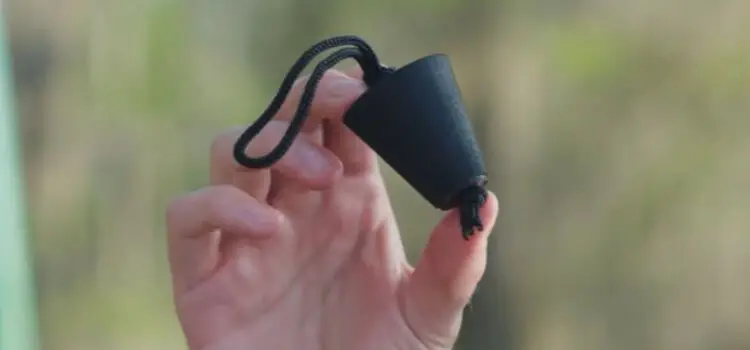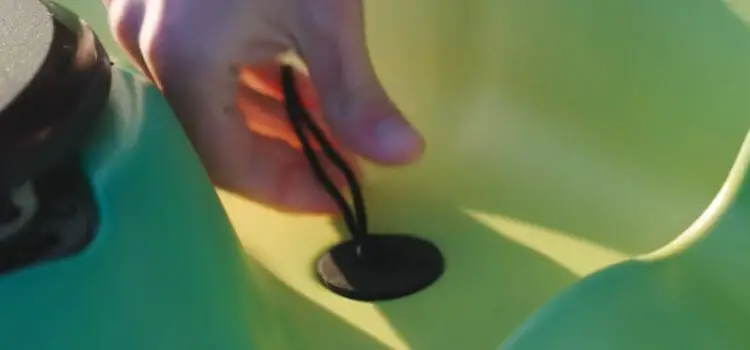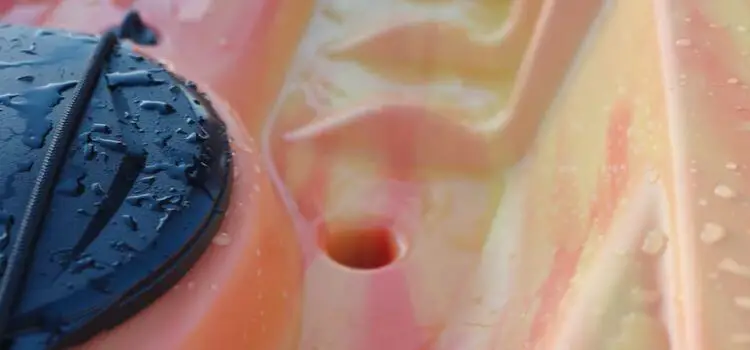As an Amazon Associates, I earn from quality purchases.
Are you a kayaking enthusiast wondering if you should invest in scupper plugs for your kayak? If you’ve ever pondered the need for these small accessories, this article will provide you with valuable insights. Scupper plugs play a crucial role in managing water inside your kayak. It ensures a comfortable and stable paddling experience.
In this guide, we’ll explore the question, “Do you need scupper plugs in a kayak?” After going through this article, you will understand the benefits you can have from the scupper plugs. So, let’s dive in and discover the importance of scupper plugs for your kayaking adventures.
What are Scupper Plugs?

A. Definition and purpose of scupper plugs
Scupper plugs are small accessories designed to fit into scupper holes found on the deck or hull of a kayak. These holes, also known as self-bailing holes, are strategically placed to allow water that enters the kayak to drain out.
However, in certain situations or personal preferences, you may want to prevent water from entering the kayak altogether. That’s where scupper plugs come in.
The primary purpose of scupper plugs is to block or restrict the flow of water through the scupper holes. It effectively prevents water from entering your kayak. By inserting scupper plugs into these holes, you can keep the interior of your kayak dry and maintain a more comfortable paddling experience.
B. Different types of scupper plugs available
Foam Scupper Plugs:
- Foam scupper plugs are commonly used and offer excellent buoyancy.
- They are lightweight and easily compressible, allowing for a snug fit in different scupper hole sizes.
- Foam plugs are typically affordable and readily available.
Rubber Scupper Plugs:
- Rubber scupper plugs provide a tight seal and are effective in preventing water from entering the kayak.
- They are durable and can withstand varying water conditions.
- Rubber plugs often come with adjustable features, allowing them to fit a range of scupper hole sizes.
Plastic Scupper Plugs:
- Plastic scupper plugs are known for their durability and resistance to wear and tear.
- They offer a secure and watertight seal, keeping your kayak dry.
- These plugs are available in different sizes to accommodate various scupper hole dimensions.
When choosing scupper plugs, consider the compatibility with your kayak’s scupper hole size, material durability, and ease of insertion and removal. Selecting the right type of scupper plug will ensure an effective and hassle-free kayaking experience.
Benefits of Using Scupper Plugs

A. Water Prevention:
1. Keeping the kayak dry:
When kayaking in calm or mild conditions, scupper plugs can effectively prevent water from entering the kayak through the scupper holes. By keeping the interior dry, you can enjoy a more comfortable and enjoyable paddling experience.
2. Minimizing water splashing during paddling:
Scupper plugs create a barrier that restricts the flow of water into the kayak, reducing the amount of water splashing onto the paddler. This can help keep you and your gear drier and more comfortable throughout your kayaking adventure.
B. Enhanced Stability:
1. Improved balance and tracking:
By using scupper plugs, you can increase the overall stability of your kayak. Water entering through the scupper holes can affect the kayak’s balance, making it more prone to rocking or tipping. With scupper plugs in place, the kayak’s stability is enhanced, allowing for better balance and smoother tracking on the water.
2. Increased resistance to tipping:
Scupper plugs provide additional buoyancy to the kayak, reducing the risk of tipping over. This is especially beneficial when paddling in rougher waters or engaging in activities such as fishing or photography, where stability is crucial.
Considerations for Using Scupper Plugs
A. Paddling Conditions:
1. Calm water vs. rough conditions:
In calm water conditions, using scupper plugs may not be necessary as the likelihood of water splashing into the kayak is minimal. However, in rougher conditions with waves or choppy waters, using scupper plugs can help prevent water from entering and enhance stability.
2. Whitewater kayaking vs. recreational kayaking:
Whitewater kayaking involves navigating turbulent and fast-moving water. In this intense paddling environment, scupper plugs are generally not recommended.
On the other hand, for recreational kayaking in calmer environments, scupper plugs can provide added benefits.
B. Personal Preference:
1. Individual comfort levels:
Some kayakers may prefer a drier paddling experience and opt to use scupper plugs regardless of the conditions. If you are sensitive to water splashing or want to keep your kayak’s interior dry, using scupper plugs can offer increased comfort.
2. Desired level of control over water drainage:
Scupper plugs allow you to control the amount of water drainage from your kayak. By removing the plugs, you can intentionally let water enter and use the scupper holes as self-bailing mechanisms.
This can be beneficial when you need to drain excess water, especially during rainy or wavy conditions.
When not to use scupper plugs?
There are a few scenarios where using scupper plugs may not be recommended:
1. Sit-on-top kayaks with dedicated scupper systems:
Some sit-on-top kayaks are specifically designed with a comprehensive scupper system. It allows water to flow freely through the kayak. In such cases, using scupper plugs can impede the kayak’s self-bailing functionality and compromise its intended design.
2. Whitewater kayaking or rough conditions:
As mentioned earlier, in high-impact paddling environments like whitewater kayaking or extremely rough conditions, scupper plugs are generally not recommended due to potential damage or dislodgment.
3. Personal preference and experimentation:
Ultimately, the decision to use scupper plugs depends on your personal preference and the specific conditions you encounter. It’s worth experimenting with and without scupper plugs to determine what works best for your comfort, stability, and overall paddling experience.
Scupper Plugs vs. Self-Bailing Design
Aspect | Scupper Plugs | Self-Bailing Systems |
Water Control | Provides control over water entry and drainage. | Automatically drains water from the cockpit. |
Versatility | Can be used in various kayak models. | Specific to kayaks with integrated systems. |
Suitability for Conditions | Ideal for calm or mild conditions. | Effective in rough water or whitewater. |
Water Splashing | Minimizes water splashing inside the kayak. | This may result in increased water splashing. |
Dryness | Helps keep the cockpit dry. | May allow some water to enter the cockpit. |
Maintenance | Easy insertion and removal for cleaning. | Minimal maintenance is required. |
Please note that the choice between scupper plugs and self-bailing systems depends on your preference, specific kayaking conditions, and the desired level of control over water management. Consider these factors when deciding which option is most suitable for your needs.
How to Choose the Right Scupper Plugs

A. Kayak compatibility:
1. Matching plug size to scupper hole size:
It’s crucial to ensure that the scupper plugs you choose are compatible with the size of the scupper holes in your kayak. Measure the diameter of your scupper holes and select plugs that match those dimensions. Using plugs that are too small or too large may result in an improper fit and compromise their effectiveness.
2. Considering different kayak models and brands:
Different kayak models and brands may have variations in scupper hole sizes and shapes. Research and check the specifications or user manual of your kayak to determine the recommended scupper plug size or any specific compatibility guidelines provided by the manufacturer.
B. Material and design considerations:
1. Foam, rubber, or plastic plugs:
Scupper plugs are available in different materials such as foam, rubber, or plastic. Each material has its advantages. Foam plugs, for example, offer excellent buoyancy and are lightweight. But rubber plugs provide a secure seal and durability.
Plastic plugs are known for their resistance to wear and tear. Consider your specific needs, preferences, and durability requirements for your kayaking activities when selecting the material for the scupper plugs.
2. Easy insertion and removal:
Look for scupper plugs that are designed for easy insertion and removal. Some plugs have a tapered shape or adjustable features. They allow them to fit snugly into the scupper holes and be easily inserted or removed as needed. This convenience can be particularly beneficial when you need to quickly adjust the water drainage or remove the plugs for cleaning purposes.
By considering kayak compatibility in terms of scupper hole size and the specific design of your kayak, as well as material and design considerations for the scupper plugs themselves, you can choose the right plugs that ensure a proper fit, effective water control, and ease of use.
You may also read: What To Wear When Kayaking Summer?
Conclusion
The answer to the question “Do you need scupper plugs in a kayak?” depends on various factors. You have to consider the type of kayaking you do, the water conditions you encounter, and your personal preference to get an answer. Scupper plugs offer significant benefits by preventing water from entering the kayak, keeping the interior dry, minimizing water splashing, and enhancing stability during your paddling adventures.
However, the decision to use scupper plugs or rely on the self-bailing design of your kayak ultimately rests on your comfort level, the specific conditions you encounter, and your desired level of control over water drainage. When choosing scupper plugs, consider kayak compatibility, matching plug size to scupper hole size, and the material and design features that best suit your needs.
So, if you’re looking for a drier and more stable kayaking experience, incorporating scupper plugs into your gear may be a wise choice.
Frequently Asked Questions (FAQs):
Q: Should I leave scupper plugs in a kayak?
A: It depends on your personal preference and the specific conditions you’ll be kayaking in. Scupper plugs are typically used to prevent water from entering the kayak through scupper holes.
If you prefer a drier paddling experience or are kayaking in calm conditions, leaving the scupper plugs in place can help keep the interior dry. However, in rougher water or when self-bailing is desired, removing the scupper plugs allows water to drain out of the kayak.
Q: Should my kayak have holes in the bottom?
A: Yes, many kayaks, especially sit-on-top models, have scupper holes in the bottom. These holes serve various purposes, including draining water that enters the kayak, preventing water accumulation, and enhancing stability. However, the presence of scupper holes does not necessarily mean that your kayak will sink or compromise its floating ability.
Q: What is the purpose of scupper holes in a kayak?
A: Scupper holes in a kayak serve multiple purposes. They allow water that enters the kayak, whether from waves, splashes, or rainfall, to drain out, keeping the interior drier. Scupper holes also enhance stability by allowing excess water to escape, reducing the risk of tipping.
In self-bailing kayaks, scupper holes are part of a drainage system that automatically removes water from the cockpit.
Q: How do I protect the bottom of my kayak?
A: You can take several measures:
- Avoid dragging the kayak on rough surfaces or abrasive terrain.
- Use a kayak cart or trolley when moving the kayak.
- Consider using keel guards or sacrificial strips, that provide an extra layer of protection to the bottom of your kayak.
- Store your kayak in a safe and secure location. Proper storage can help prevent unnecessary wear and tear on the bottom of the kayak.
Q: Will a kayak sink without scupper plugs?
A: It is highly unlikely for a kayak to sink solely due to the absence of scupper plugs. Most kayaks are designed with built-in buoyancy and flotation chambers. They help maintain their floating ability even if water enters the cockpit.
While a kayak won’t sink without scupper plugs, using them offers significant advantages in terms of water prevention and stability, making them a valuable accessory for many kayakers.

Leave a Reply